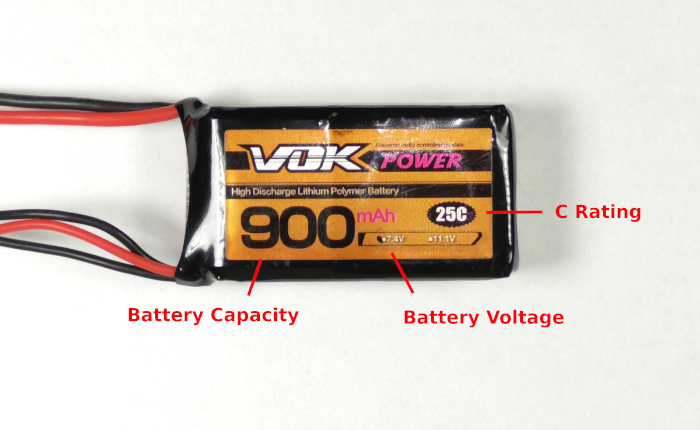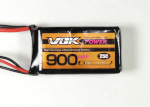Introduction
Battery Parameters
Lithium Polymer (LiPO) Batteries
LiPO cells have a nominal voltage of 3.7 volts per cell. A fully charged LiPO is at 4.2 volts per cell and it can safely be discharged to 3.0 volts per cell. An actual LiPO battery is composed of one or more cells and this determines the overall voltage of the battery pack. The batteries are labeled to identify this with a designation such as “2S” or “3S”. The number denotes how many cells are in the pack and the S denotes that the cells are in series, in other words the cell voltages are added up. To find the voltage of the battery pack multiply the cell count by 3.7 volts. Often the voltage is conveniently marked on the battery, but this isn’t always the case.
The second parameter to be aware of is the capacity of the battery. This will be marked on the battery as something like “2600 mAh”. This means that the battery can supply 2.6 amps for one hour, at which point the battery pack will be fully discharged. You’ll need to determine how much current your project draws and use the capacity value to find out how much run time a given battery will provide. LiPO batteries are available in a range of capacities from a few hundred mAh up to 20,000 mAh.
We’ve looked at voltage and capacity, but how much current can you pull from a LiPO battery? After all if the battery can’t supply the current you need your robot won’t operate properly. The answer lies in the “C rating” of the battery. The battery will usually be labeled with a marking such as “5C” or “10C”. This value is used to determine how much current the battery can supply. Simply multiply the battery’s capacity in amp hours by the C rating and the result is the current the battery is capable of supplying. For example, a 2000 mAh battery with a 20C rating is: 2 Ah * 20C = 40 amps. Note that there are often two C ratings on a battery. The first is the constant rating, or the amount of current that can be supplied for any amount of time. The second C rating is the peak value. This is the amount of current that can be supplied in short burst, usually no longer than 5-10 seconds.

Figure 1: LiPO battery specifications labeled.
Lithium Iron Phosphate (LiFePO4) Batteries
LiFePO4 cells have a nominal voltage of 3.2 volts. A fully charged cell sits at a voltage of 3.65 volts and a cell is fully discharged when it reaches 2.8 volts. As with LiPo batteries the voltage of the pack is the nominal voltage of 3.2 volts multiplied by the number of cells in series. A common example is a 3s battery pack. A 3s LiFePO4 pack will have a nominal voltage of 9.6 volts and a will be at 10.95 volts fully charged.
LiFePO4 batteries can be found in an even wider range of capacities than LiPO batteries. Small packs in the 600 mAh range can be easily found and very large packs exceeding 100 Ah can also be found. Note that very large LiFePO4 packs are still quite expensive and this may be a factor in whether or not you decide to use one.
Lead Acid Batteries
Lead acid batteries have a nominal voltage of 2 volts per cell. This means they come in even numbered voltages such as 6 volts or 12 volts. A fully charged lead acid battery will be at 2.1 volts per cell and fully discharged is at 1.97 volts per cell. However, lead acid batteries don’t tolerate being fully discharged well and should only be discharged to about 50% of their capacity rating, or a voltage of around 2.03 volts per cell.
As with LiPO batteries, the capacity of a lead acid battery is measure in amp hours (Ah).
Lead acid batteries are available in capacities from a handful of amp hours to hundreds of amp hours. However, lead acid batteries should only be discharged to around 50% of their total capacity to reduce damage to the cells. Overly discharging a lead acid battery will reduce the total number of times it can be recharged in the future. Factor this reduced capacity in when selecting a battery for a given run time in your robot.
Lead acid batteries tend to self-discharge when stored for long periods of time. This means that the voltage of the battery falls while not in use. When the voltage falls too low the battery can be damaged. To prevent damage from occurring and to keep the battery ready to use a float or trickle charger can be used to maintain the battery at a healthy voltage.
Lead acid batteries typically have a lower C rating than LiPO batteries, but due to their often large capacities can still supply large amounts of current. This is why they are used as starting batteries for vehicles which can require anywhere between 10 and a few hundred amps when starting an engine.

